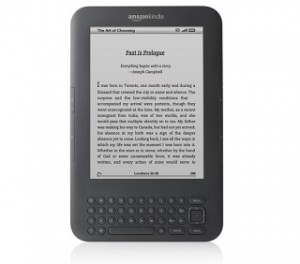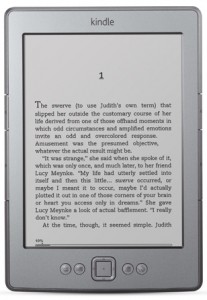 With the Kindle Fire opening up whole new avenues of entertainment in the product line and the Kindle Touch providing the affordable touchscreen eReader that people have been asking for for years now, there is a sense that both the Kindle Keyboard (Kindle 3) and just plain “Kindle” (Kindle 4) are superfluous. Sure the low price on the basic Kindle is great, for example, but for only a $20 difference over the touchscreen model you are asserting that you will never need an audiobook and don’t have much interest in note taking. Sometimes it is nice to retain those capabilities just in case, even if you have no interest in them from day to day. This absolutely does not mean that there is no situation where that is the smart move to make, it just means that being aware of your needs is important.
With the Kindle Fire opening up whole new avenues of entertainment in the product line and the Kindle Touch providing the affordable touchscreen eReader that people have been asking for for years now, there is a sense that both the Kindle Keyboard (Kindle 3) and just plain “Kindle” (Kindle 4) are superfluous. Sure the low price on the basic Kindle is great, for example, but for only a $20 difference over the touchscreen model you are asserting that you will never need an audiobook and don’t have much interest in note taking. Sometimes it is nice to retain those capabilities just in case, even if you have no interest in them from day to day. This absolutely does not mean that there is no situation where that is the smart move to make, it just means that being aware of your needs is important.
I think that the obvious contrast will be between the Kindle Fire and the Kindle products with mechanical interfaces. While I will maintain that there is a definite difference between the new tablet and the eReader line it is billed as a part of, Amazon’s association of the two types of hardware under the same brand name makes the comparison important. It’s true that much of the argument also goes for the Kindle Touch, right now we can look at the Kindle and Kindle Keyboard hands-on. That makes things a bit simpler.
Naturally I could go on again about the superior reading experience to be found in an E INK Pearl screen over pretty much any LCD we’re ever likely to see. Fortunately, I think most people have come to accept that already. The battery life issue is also a big one, but not worth dwelling on. It is not likely that people would fail to see the benefits of only having to charge a portable device every few weeks. What I will contend is that there is an advantage to be found in the simplified experience of the Kindle and Kindle Keyboard over that we can expect from the Kindle Fire.
Since the Kindle is traditionally associated with reading and I’m talking about the virtues of the less expensive members of the Kindle family, it’s only natural that a great deal of weight is to be placed on the act of reading. For example, I consider it a great advantage to be able to read without the distractions offered by a multi-functional device. I won’t deny this owes to my own easily distracted nature, but that’s hardly an uncommon trait. Reading a book should not generally be an act of willpower overcoming the urge to do something else. That detracts somehow. With a Kindle or Kindle Keyboard, not only can you do little besides read, most of what else you are able to do revolves around acquiring more things to read. It is a cohesive experience.
The fact that both of the Kindles in question make use of mechanical controls rather than a touch interface can also be an advantage. Aside from any risk of fingerprints being left, many people will prefer to be able to navigate their eBooks via the page turn buttons on the sides of the device. When using a Kindle Keyboard, for example, you can adjust your grip to allow for page turning with nothing more than a light squeeze of the thumb. Even assuming this is possible on a touchscreen, it would involve covering part of the display. You may only save a small motion, but when Amazon is looking to save on even the effort of a swiping gesture in their touch interface there is obviously a preference for conserved effort in the user base.
 The Kindle Keyboard in particular also offers the distinct advantage of being able to interact with your device without tying up screen real estate. Normally this is not a big deal, I will be the first to admit. When it comes to making in-text notations, however, it is useful to be able to see as much as possible while forming your thoughts. I do think that the Kindle Touch and Kindle Fire will offer a greater speed to the notation process since selecting text is a bit clunky with the more basic directional control, but it is useful to be aware of the tradeoff. Losing the keyboard was worthwhile in terms of reducing size and weight, but for some people the keyboard is still a useful part of the Kindle experience. Learn how to open NUMBERS file.
The Kindle Keyboard in particular also offers the distinct advantage of being able to interact with your device without tying up screen real estate. Normally this is not a big deal, I will be the first to admit. When it comes to making in-text notations, however, it is useful to be able to see as much as possible while forming your thoughts. I do think that the Kindle Touch and Kindle Fire will offer a greater speed to the notation process since selecting text is a bit clunky with the more basic directional control, but it is useful to be aware of the tradeoff. Losing the keyboard was worthwhile in terms of reducing size and weight, but for some people the keyboard is still a useful part of the Kindle experience. Learn how to open NUMBERS file.
This is not a claim for the overarching superiority of the older Kindle Keyboard or even the equality of the Kindle 4 (there is a reason that it is priced lower than all the other Kindles). What I am claiming is that they each fill niches separate from the Kindle Fire and, to a lesser degree, the Kindle Touch. Yes the newer, more powerful device can do basically all the same things that the eReaders are able to do as well as many other things that people will find useful, but that does not mean that it is a direct upgrade. For an affordable tablet, the Kindle Fire is great. For an eReader I would recommend any other Kindle without hesitation. There is no more reason to disregard the Kindle or the Kindle Keyboard than there is to ignore the situational usefulness of the Kindle DX, which is an issue I have also gotten into recently. Know your options and your needs when you decide it is time for a new Kindle.
Simple difference for me: My Kindle 3 Keyboard I’ll bring to the beach and on 2-3 day business trips for the plane. No battery necessary. It’s my reader.
The Kindle Fire is the tablet I’ll probably mostly keep at home for movie and magazine viewing. I really doubt I’ll use it much for traditional books.